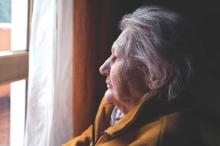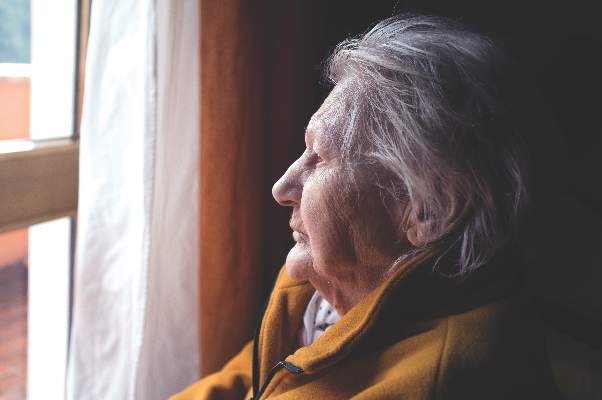User login
New findings show there are several major risk factors that influence late-life depression (LLD), with physical/functional limitations the most prevalent, according to Shun-Chiao Chang, ScD, of Brigham and Women’s Hospital, Boston, and her associates.
They examined 21,728 women aged older than 65 years who had no prior depression. During a 10-year follow-up, 3,945 incident LLD cases were identified. In those cases, social factors and lifestyle/behavioral factors did affect LLD, but the categories with the largest effect magnitudes for higher LLD risk were severe/very severe bodily pain (hazard ratio, 2.22; 95% confidence interval, 1.88-2.62), difficulty sleeping most/all the time (HR, 2.04; 95% CI, 1.77-2.36), and daily sleep of 10 hours or more (HR, 1.96; 95% CI, 1.56-2.46). The most prevalent risk factor, physical/functional limitations, was associated with a 42% increase in risk
Sleep difficulty some to all of the time, no/very little exercise, and moderate to very severe bodily pain also were factors, with population attributable fraction (PAF) values of 10% or higher. The factor with the largest PAF was physical/functional limitation (26.4%).
Overall, the behavioral factors appeared to contribute relatively equally to LLD among women with and without physical/functional limitations; however, health factors had much bigger contributions to risk among women with limitations.
“Together, model predictors accounted for almost 60% of all new LLD cases in this population, and physical/functional limitation is the largest single contributor to total risk,” the researchers concluded. “A substantial proportion of LLD cases may be preventable by increasing exercise and intervening or preventing sleep difficulties and pain.”
Find the full study in Preventive Medicine (doi: 10.1016/j.ypmed.2016.08.014).
New findings show there are several major risk factors that influence late-life depression (LLD), with physical/functional limitations the most prevalent, according to Shun-Chiao Chang, ScD, of Brigham and Women’s Hospital, Boston, and her associates.
They examined 21,728 women aged older than 65 years who had no prior depression. During a 10-year follow-up, 3,945 incident LLD cases were identified. In those cases, social factors and lifestyle/behavioral factors did affect LLD, but the categories with the largest effect magnitudes for higher LLD risk were severe/very severe bodily pain (hazard ratio, 2.22; 95% confidence interval, 1.88-2.62), difficulty sleeping most/all the time (HR, 2.04; 95% CI, 1.77-2.36), and daily sleep of 10 hours or more (HR, 1.96; 95% CI, 1.56-2.46). The most prevalent risk factor, physical/functional limitations, was associated with a 42% increase in risk
Sleep difficulty some to all of the time, no/very little exercise, and moderate to very severe bodily pain also were factors, with population attributable fraction (PAF) values of 10% or higher. The factor with the largest PAF was physical/functional limitation (26.4%).
Overall, the behavioral factors appeared to contribute relatively equally to LLD among women with and without physical/functional limitations; however, health factors had much bigger contributions to risk among women with limitations.
“Together, model predictors accounted for almost 60% of all new LLD cases in this population, and physical/functional limitation is the largest single contributor to total risk,” the researchers concluded. “A substantial proportion of LLD cases may be preventable by increasing exercise and intervening or preventing sleep difficulties and pain.”
Find the full study in Preventive Medicine (doi: 10.1016/j.ypmed.2016.08.014).
New findings show there are several major risk factors that influence late-life depression (LLD), with physical/functional limitations the most prevalent, according to Shun-Chiao Chang, ScD, of Brigham and Women’s Hospital, Boston, and her associates.
They examined 21,728 women aged older than 65 years who had no prior depression. During a 10-year follow-up, 3,945 incident LLD cases were identified. In those cases, social factors and lifestyle/behavioral factors did affect LLD, but the categories with the largest effect magnitudes for higher LLD risk were severe/very severe bodily pain (hazard ratio, 2.22; 95% confidence interval, 1.88-2.62), difficulty sleeping most/all the time (HR, 2.04; 95% CI, 1.77-2.36), and daily sleep of 10 hours or more (HR, 1.96; 95% CI, 1.56-2.46). The most prevalent risk factor, physical/functional limitations, was associated with a 42% increase in risk
Sleep difficulty some to all of the time, no/very little exercise, and moderate to very severe bodily pain also were factors, with population attributable fraction (PAF) values of 10% or higher. The factor with the largest PAF was physical/functional limitation (26.4%).
Overall, the behavioral factors appeared to contribute relatively equally to LLD among women with and without physical/functional limitations; however, health factors had much bigger contributions to risk among women with limitations.
“Together, model predictors accounted for almost 60% of all new LLD cases in this population, and physical/functional limitation is the largest single contributor to total risk,” the researchers concluded. “A substantial proportion of LLD cases may be preventable by increasing exercise and intervening or preventing sleep difficulties and pain.”
Find the full study in Preventive Medicine (doi: 10.1016/j.ypmed.2016.08.014).
FROM PREVENTIVE MEDICINE

